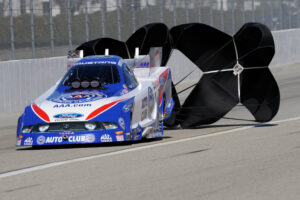During my live lessons I use an analogy often – that a powerful swing is quite a bit like a drag racer.
Let me explain what I mean.
Dragsters will do 1/4 mile in under 4 seconds, crossing the finish line with top speeds in excess of 300 mph. They take off with an explosive burst, and are still accelerating as they cross the line.
These cars are moving so fast, they need parachutes to slow them down before they run into the hay bales at the end of the runway. They don’t want to risk damage to the car (especially after so many people involved have looked at safeco insurance reviews and the like to protect their investment), so they definitely try to stop short of these.
Two excellent parallels can be made from this: One, that the length of the runway greatly determines the top speed of the car, or golf swing. A short backswing and/or follow through will greatly curtail your ability to produce top speed. Imagine if the dragsters only raced a hundred yards – 50 mph might win!
Our golf swings are very similar. I get a lot of students who makes short swings, especially during the follow through. Imagine if the hay bales were just across the finish line – you’d be hitting the brakes before the race was won! A super long follow through provides more time to decelerate the club, and therefore allows us to keep accelerating through impact.
The fastest part of a good golf swing is about 30 inches past potential impact (assuming no collision of course) when both arms are straight for the only time. Mike Austin used to say that he was measured at 150 mph at impact, but 155 mph shortly after (with no ball). He claimed that after impact with the ball, for a very brief period his club would speed back up again.
And the second, your ability to slow down to a stop before taking damage is equally important to the acceleration phase. We can only swing as fast as we can slow the club down.
Our muscles have cells called Golgi Tendon Organs, which sense the amount and rate of stretch in the muscle. If they determine that the muscle is on pace to be injured, they will contract and thereby slow the rate of change in a joint. They are your emergency parachute.

The drag racer cannot rely solely on brakes to reduce speed – they use one or even two parachutes deployed at the finish line to assist deceleration. We need our muscles and joints to develop the same braking capacity after impact to both reduce risk of damage (injury) and guarantee high potential velocity.
This is where the proper speed training techniques come in. It’s great to practice going swinging fast, but you’d better pay attention to the deceleration phase as well. It’s all covered inside the site under the ‘speed training’ tab.
